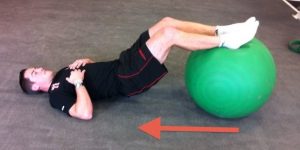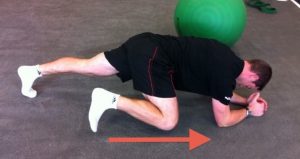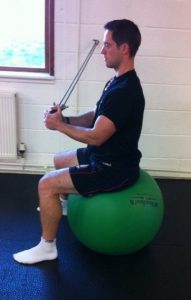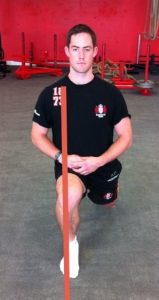The core is a general phase encompassing the muscles of the lower abdomen and the pelvis. When they work well together they help to keep the trunk stable allowing the arm and leg muscles to function to their best ability. At Bristol Physio we think the ‘core’ or central pillar can be very important for reducing the risk of injury.
In all sports the core muscles have to be strong to allow good movements when doing all movements especially jumping, cutting and throwing. A good ‘core’ will also allow you to be strong through the middle of your body stabilising your spine and will often reduce back, neck, shoulder or hip pain. Very often the core of everyone could be improved as it will increase their general strength, speed and allow the individual to reduce the risk of injury.
Most core exercises focus on muscles deeper to the ones you see on the outside such as the abdominals. Muscles like the pelvic floor and the transverse abdominal muscle will be worked with all these exercises below. These can all be incorporated into a balanced strength and conditioning program if you have one.
If you have pain, often a more bespoke exercise regime will be more beneficial and all our therapists can give advice on this. You can find out more information on core exercises on our YouTube Channel. Subscribe for regular exercise videos. We have videos for horse riders, those with back pain and surfers.
These exercises are in no particular order:
Deadbugs –Good for abs and lower core muscles.
Reaching out right hand to right knee.

Can alternate to reach across your body.

Glut bridge with theraband or glut band – good for gluts and lower back muscles.
With band around top of knees, squeeze bottom together prior to lifting off the ground.

Make sure band is tight before you lift bottom off the ground. Always make sure you keep the knee in line with the hips, don’t let them get pulled inwards.

Glut-hamstring curls – good for gluts and hamstrings.
Feet placed evenly on top of the ball. Squeeze bottom together before lifting up.

Dig heels into ball as pulling it towards your bottom.

Jack knife –good for abs and hip flexors.
Start in plank position on the ball.

Slowly bring ball towards you, bring knees up to chest.

Monster and crab walks – good for gluts and groin muscles.
Monster –Tight band around ankles, start in ¼ squat position.
Stride out leg at 45 degrees and place down with toes first. Let other leg slowly join the first then continue. Don’t leg legs bash together.

Crab – Same as Monster walks but side on. Note the ¼ squat position. Also add arm movement like you would when running.

Plank – Good for abs and inner core muscles.
Normal plank with rigid body and low hips.

Dynamic plank with movement of knee up towards the chest.

Side Plank– Good for abs and obliques, also good for groin.
On side resting on forearm and top leg making sure hips stay up towards the ceiling and body straight.

Dynamic side plank involves pulling the bottom knee up towards the chest and back down again.

Superman’s– good for core control and lower back muscles.
Start in a 90/90 position, shoulders and hips at 90 degrees.

Extend leg and opposite arm out. Make sure pelvis stays level, it shouldn’t rotate.

Thoracic rotation on gym ball – good for back and lower core muscles and obliques.
Sit with good posture on the ball with the band off at 90 degrees to your body, holding it with 2 hands in front of belly button.

Rotate whole body away from the wall using the band as resistance against the movement. Make sure you have good posture all the time.

Walking lunges– good for gluts, groin, hamstrings, abs and back muscles.
Walking lunge forwards making sure good posture and knee always over the second to third toe.

Weight should drop down evenly between feet, that means front and back knee have to bend. Also note the front knee cap behind the toes.

The core is a general phase encompassing the muscles of the lower abdomen and the pelvis. When they work well together they help to keep the trunk stable allowing the arm and leg muscles to function to their best ability. At Bristol Physio we think the ‘core’ or central pillar can be very important for reducing the risk of injury.
In all sports the core muscles have to be strong to allow good movements when doing all movements especially jumping, cutting and throwing. A good ‘core’ will also allow you to be strong through the middle of your body stabilising your spine and will often reduce back, neck, shoulder or hip pain. Very often the core of everyone could be improved as it will increase their general strength, speed and allow the individual to reduce the risk of injury.
Most core exercises focus on muscles deeper to the ones you see on the outside such as the abdominals. Muscles like the pelvic floor and the transverse abdominal muscle will be worked with all these exercises below. These can all be incorporated into a balanced strength and conditioning program if you have one.
If you have pain, often a more bespoke exercise regime will be more beneficial and all our therapists can give advice on this. You can find out more information on core exercises on our YouTube Channel. Subscribe for regular exercise videos. We have videos for horse riders, those with back pain and surfers.
These exercises are in no particular order:
Deadbugs –Good for abs and lower core muscles.
Reaching out right hand to right knee.

Can alternate to reach across your body.

Glut bridge with theraband or glut band – good for gluts and lower back muscles.
With band around top of knees, squeeze bottom together prior to lifting off the ground.

Make sure band is tight before you lift bottom off the ground. Always make sure you keep the knee in line with the hips, don’t let them get pulled inwards.

Glut-hamstring curls – good for gluts and hamstrings.
Feet placed evenly on top of the ball. Squeeze bottom together before lifting up.

Dig heels into ball as pulling it towards your bottom.

Jack knife –good for abs and hip flexors.
Start in plank position on the ball.

Slowly bring ball towards you, bring knees up to chest.

Monster and crab walks – good for gluts and groin muscles.
Monster –Tight band around ankles, start in ¼ squat position.
Stride out leg at 45 degrees and place down with toes first. Let other leg slowly join the first then continue. Don’t leg legs bash together.

Crab – Same as Monster walks but side on. Note the ¼ squat position. Also add arm movement like you would when running.

Plank – Good for abs and inner core muscles.
Normal plank with rigid body and low hips.

Dynamic plank with movement of knee up towards the chest.

Side Plank– Good for abs and obliques, also good for groin.
On side resting on forearm and top leg making sure hips stay up towards the ceiling and body straight.

Dynamic side plank involves pulling the bottom knee up towards the chest and back down again.

Superman’s– good for core control and lower back muscles.
Start in a 90/90 position, shoulders and hips at 90 degrees.

Extend leg and opposite arm out. Make sure pelvis stays level, it shouldn’t rotate.

Thoracic rotation on gym ball – good for back and lower core muscles and obliques.
Sit with good posture on the ball with the band off at 90 degrees to your body, holding it with 2 hands in front of belly button.

Rotate whole body away from the wall using the band as resistance against the movement. Make sure you have good posture all the time.

Walking lunges– good for gluts, groin, hamstrings, abs and back muscles.
Walking lunge forwards making sure good posture and knee always over the second to third toe.

Weight should drop down evenly between feet, that means front and back knee have to bend. Also note the front knee cap behind the toes.

